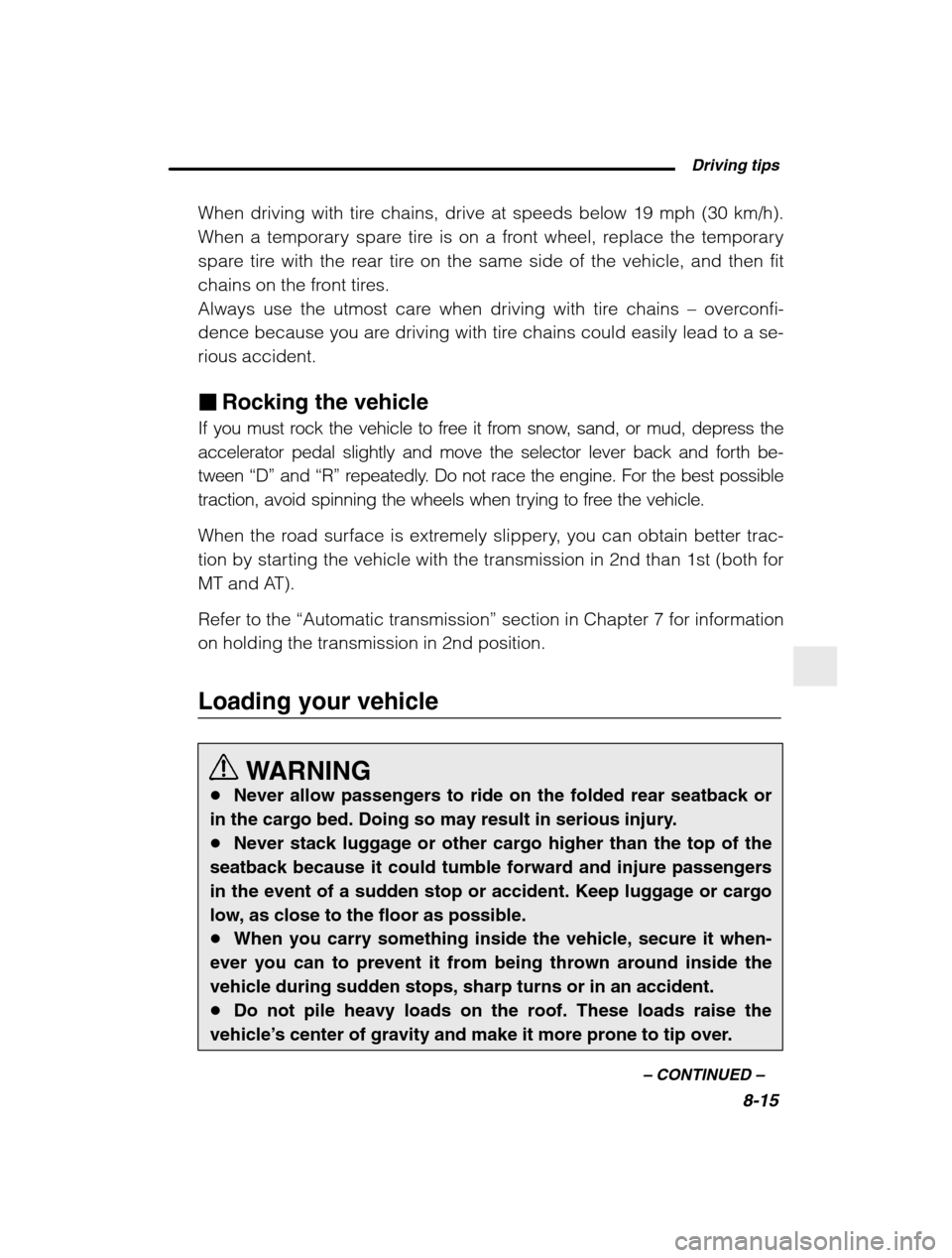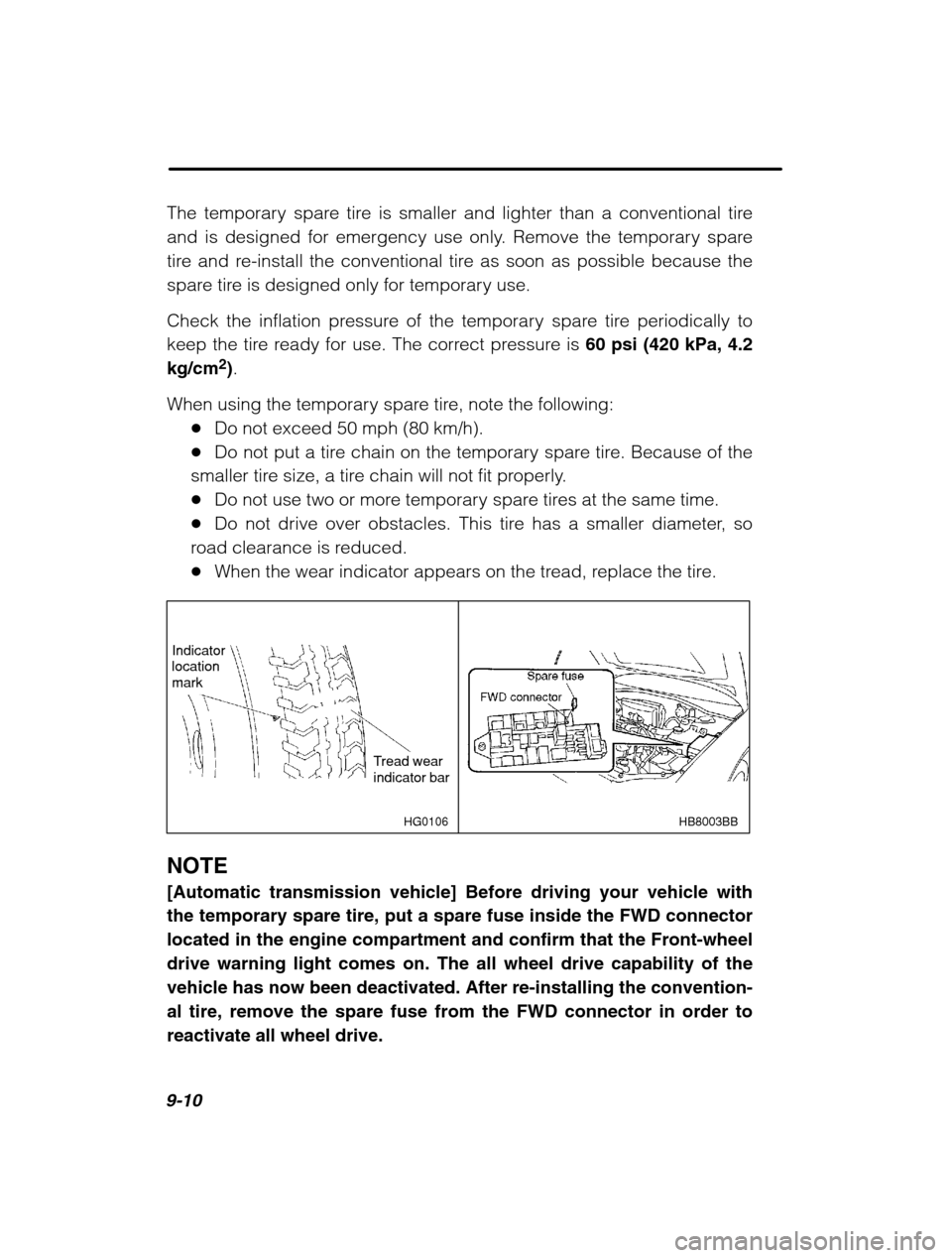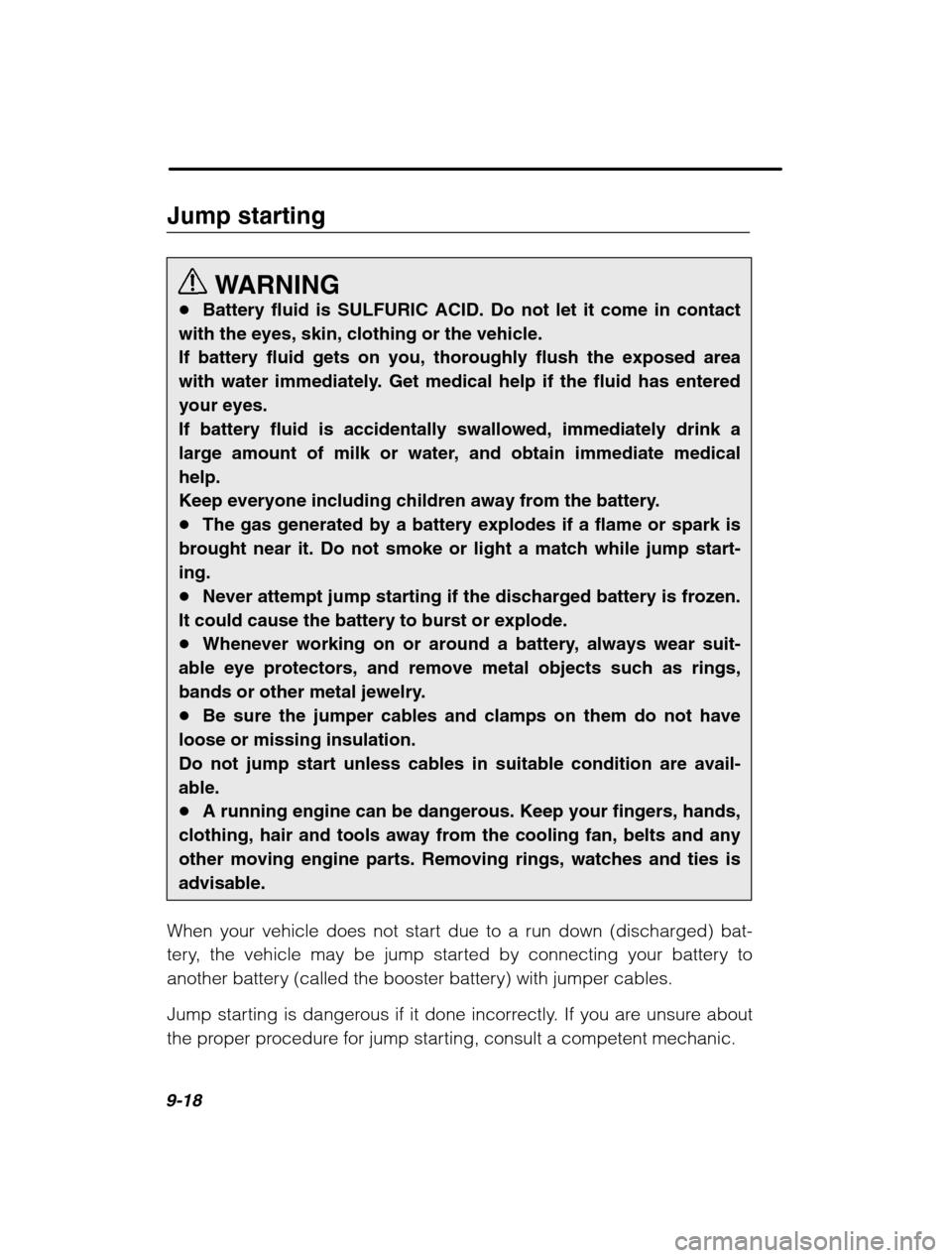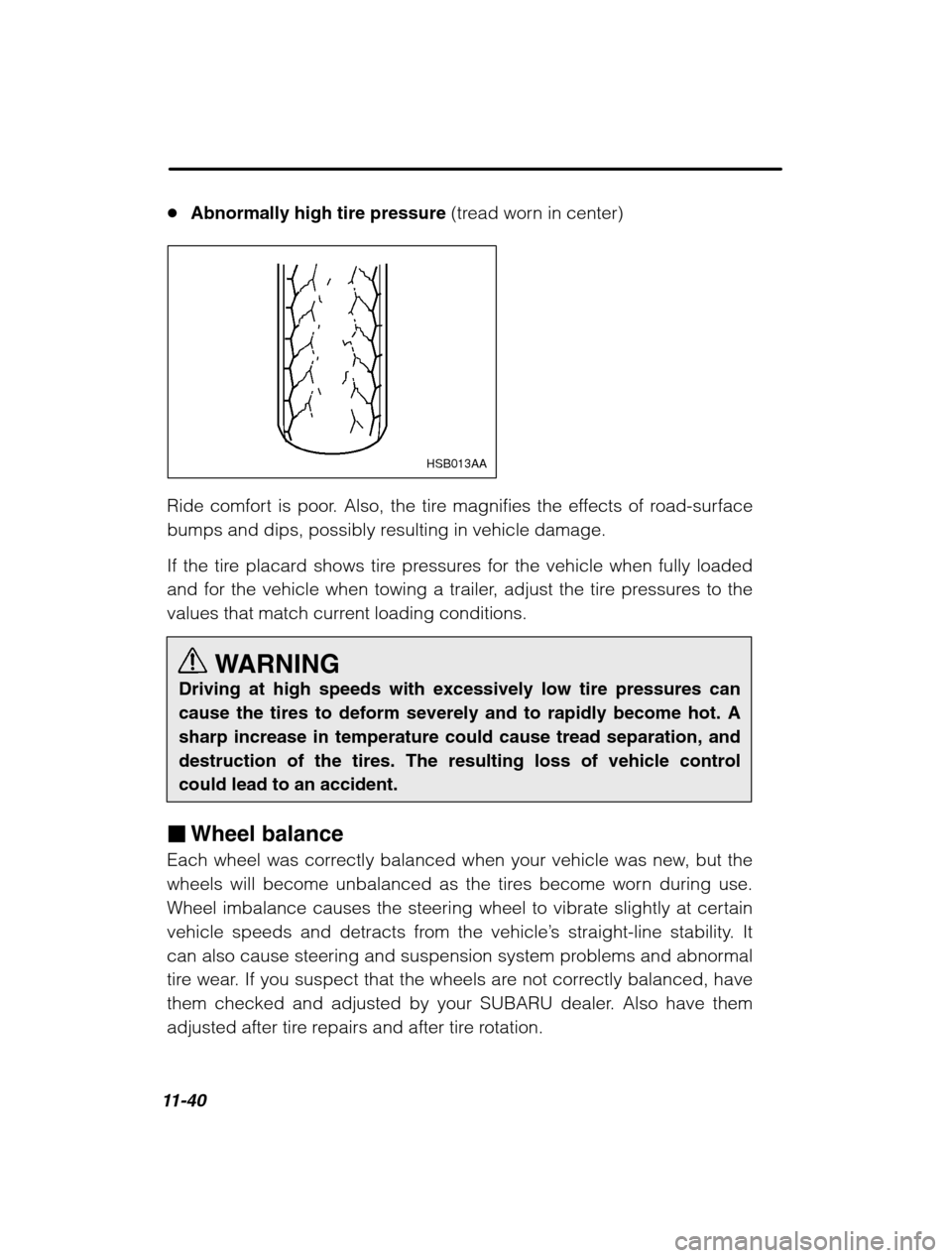2003 SUBARU BAJA warning light
[x] Cancel search: warning lightPage 233 of 400

Starting and operating7-27
–
CONTINUED –
CAUTION
Never drive while the parking brake is set because this will cause
unnecessary wear on the brake linings. Before starting to drive,always make sure that the parking brake has been fully released.
To set the parking brake, press the brake pedal firmly and hold it down
while fully pulling up the parking brake lever.
HB4001BA
To release the parking brake, pull the lever up slightly, press the release
button, then lower the lever while keeping the button pressed.
When the parking brake is set while the engine is running, the parking
brake warning light comes on. After starting the vehicle, be sure that the
warning light has gone out before the vehicle is driven. Refer to the“ Warning and indicator lights ” section (Chapter 3).
When parking your vehicle, always set the parking brake firmly and putthe shift lever in the “1” (1st) for an upgrade or “R” (Reverse) for a down-
grade for manual transmission vehicles, or in the “P” (Park) position for
automatic transmission vehicles. Always set the parking brake firmly
when parking your vehicle. Never rely on the transmission alone to holdthe vehicle.
Page 253 of 400

Driving tips8-15
–
CONTINUED –
When driving with tire chains, drive at speeds below 19 mph (30 km/h).
When a temporary spare tire is on a front wheel, replace the temporary
spare tire with the rear tire on the same side of the vehicle, and then fit
chains on the front tires.
Always use the utmost care when driving with tire chains – overconfi-
dence because you are driving with tire chains could easily lead to a se-rious accident. � Rocking the vehicle
If you must rock the vehicle to free it from snow, sand, or mud, depress the
accelerator pedal slightly and move the selector lever back and forth be-
tween “D” and “R” repeatedly. Do not race the engine. For the best possible
traction, avoid spinning the wheels when trying to free the vehicle.
When the road surface is extremely slippery, you can obtain better trac-
tion by starting the vehicle with the transmission in 2nd than 1st (both for
MT and AT). Refer to the “Automatic transmission ” section in Chapter 7 for information
on holding the transmission in 2nd position.
Loading your vehicle
WARNING
� Never allow passengers to ride on the folded rear seatback or
in the cargo bed. Doing so may result in serious injury. � Never stack luggage or other cargo higher than the top of the
seatback because it could tumble forward and injure passengersin the event of a sudden stop or accident. Keep luggage or cargo
low, as close to the floor as possible. � When you carry something inside the vehicle, secure it when-
ever you can to prevent it from being thrown around inside the
vehicle during sudden stops, sharp turns or in an accident.� Do not pile heavy loads on the roof. These loads raise the
vehicle’ s center of gravity and make it more prone to tip over.
Page 272 of 400

8-34
trailer, causing sway. Crosswinds can be due to weather conditions or
the passing of large trucks or buses. If swaying occurs, firmly grip the
steering wheel and slow down immediately but gradually.�When passing other vehicles, considerable distance is required
because of the added weight and length caused by attaching the
trailer to your vehicle.� Backing up with a trailer is difficult and takes practice. When back-
ing up with a trailer, never accelerate or steer rapidly. When turning
back, grip the bottom of the steering wheel with one hand and turn it
to the left for a left turn, and turn it to the right for a right turn.
Left turn Right turn
OM-H2791
� If the ABS warning light illuminates while the vehicle is in motion,
stop towing the trailer and have repairs performed immediately by the
nearest SUBARU dealer. n Driving on grades
� Before going down a steep hill, slow down and shift into lower gear
(if necessary, use 1st gear) in order to utilize the engine braking effect
and prevent overheating of your vehicle ’s brakes. Do not make sud-
den downshifts.� When driving uphill in hot weather, the air conditioner may turn off
automatically to protect the engine from overheating.� When driving uphill in hot weather, pay attention to the water tem-
perature gauge pointer (for all vehicles) and AT OIL TEMP warning
light (for AT vehicles) since the engine and transmission are relatively
prone to overheating under these conditions. If the water temperature
Page 273 of 400

Driving tips8-35
–
CONTINUED –
gauge pointer approaches the OVERHEAT zone or the AT OIL TEMP
warning light illuminates, immediately switch off the air conditioner
and stop the vehicle at the nearest safe place. Refer to the “Engine
overheat” section in Chapter 9, and “Warning and indicator lights ”
section in Chapter 3.� If your vehicle has an automatic transmission, avoid using the
accelerator pedal to stay stationary on an uphill slope instead of usingthe parking brake or foot brake. That may cause the transmission fluidto overheat. Also, if your vehicle is equipped with an automatic trans-mission, avoid driving with the gear selector lever in “D” when towing
a heavy trailer to prevent fluid overheating. A lower gear should beused. n Parking on a grade
Always block the wheels under both vehicle and trailer when parking.
Apply the parking brake firmly. You should not park on a hill or slope.But if parking on a hill or slope cannot be avoided, you should takethe following steps:
1. Apply the brakes and hold the pedal down.
2. Have someone place wheel blocks under both the vehicle and
trailer wheels.
3. When the wheel blocks are in place, release the regular brakes
slowly until the blocks absorb the load.
4. Apply the regular brakes and then apply the parking brake; slowly
release the regular brakes.
5. Shift into 1st or reverse gear (manual transmission) or “P” (auto-
matic transmission) and shut off the engine.
Page 284 of 400

9-10
The temporary spare tire is smaller and lighter than a conventional tire
and is designed for emergency use only. Remove the temporary spare
tire and re-install the conventional tire as soon as possible because the
spare tire is designed only for temporary use.
Check the inflation pressure of the temporary spare tire periodically to
keep the tire ready for use. The correct pressure is 60 psi (420 kPa, 4.2
kg/cm 2
).
When using the temporary spare tire, note the following: �Do not exceed 50 mph (80 km/h).
� Do not put a tire chain on the temporary spare tire. Because of the
smaller tire size, a tire chain will not fit properly.� Do not use two or more temporary spare tires at the same time.
� Do not drive over obstacles. This tire has a smaller diameter, so
road clearance is reduced.� When the wear indicator appears on the tread, replace the tire.
HB8003BB
HG0106
Indicator location mark
Tread wear indicator bar
NOTE [Automatic transmission vehicle] Before driving your vehicle with the temporary spare tire, put a spare fuse inside the FWD connectorlocated in the engine compartment and confirm that the Front-wheeldrive warning light comes on. The all wheel drive capability of the
vehicle has now been deactivated. After re-installing the convention-al tire, remove the spare fuse from the FWD connector in order to
reactivate all wheel drive.
Page 292 of 400

9-18
Jump startingWARNING
� Battery fluid is SULFURIC ACID. Do not let it come in contact
with the eyes, skin, clothing or the vehicle. If battery fluid gets on you, thoroughly flush the exposed area
with water immediately. Get medical help if the fluid has enteredyour eyes. If battery fluid is accidentally swallowed, immediately drink a
large amount of milk or water, and obtain immediate medicalhelp.
Keep everyone including children away from the battery.� The gas generated by a battery explodes if a flame or spark is
brought near it. Do not smoke or light a match while jump start-ing.� Never attempt jump starting if the discharged battery is frozen.
It could cause the battery to burst or explode.� Whenever working on or around a battery, always wear suit-
able eye protectors, and remove metal objects such as rings,
bands or other metal jewelry.� Be sure the jumper cables and clamps on them do not have
loose or missing insulation.Do not jump start unless cables in suitable condition are avail-able.� A running engine can be dangerous. Keep your fingers, hands,
clothing, hair and tools away from the cooling fan, belts and anyother moving engine parts. Removing rings, watches and ties isadvisable.
When your vehicle does not start due to a run down (discharged) bat-
tery, the vehicle may be jump started by connecting your battery to
another battery (called the booster battery) with jumper cables.
Jump starting is dangerous if it done incorrectly. If you are unsure about
the proper procedure for jump starting, consult a competent mechanic.
Page 350 of 400

11-40
�Abnormally high tire pressure (tread worn in center)
HSB013AA
Ride comfort is poor. Also, the tire magnifies the effects of road-surface
bumps and dips, possibly resulting in vehicle damage.
If the tire placard shows tire pressures for the vehicle when fully loaded
and for the vehicle when towing a trailer, adjust the tire pressures to the
values that match current loading conditions.
WARNING
Driving at high speeds with excessively low tire pressures can
cause the tires to deform severely and to rapidly become hot. Asharp increase in temperature could cause tread separation, and
destruction of the tires. The resulting loss of vehicle controlcould lead to an accident.
� Wheel balance
Each wheel was correctly balanced when your vehicle was new, but the
wheels will become unbalanced as the tires become worn during use.
Wheel imbalance causes the steering wheel to vibrate slightly at certain
vehicle speeds and detracts from the vehicle ’s straight-line stability. It
can also cause steering and suspension system problems and abnormal
tire wear. If you suspect that the wheels are not correctly balanced, have
them checked and adjusted by your SUBARU dealer. Also have them
adjusted after tire repairs and after tire rotation.
Page 358 of 400

11-48
BatteryWARNING
� Before beginning work on or near any battery, be sure to extin-
guish all cigarettes, matches, and lighters. Never expose a bat- tery to an open flame or electric sparks. Batteries give off a gaswhich is highly flammable and explosive.� For safety, in case an explosion does occur, wear eye protec-
tion or shield your eyes when working near any battery. Never
lean over a battery.� Do not let battery fluid contact eyes, skin, fabrics, or paint be-
cause battery fluid is a corrosive acid. If battery fluid gets on yourskin or in your eyes, immediately flush the area with water thor-
oughly. Seek medical help immediately if acid has entered theeyes.If battery fluid is accidentally swallowed, immediately drink a
large amount of milk or water, and seek medical attention
immediately.� To lessen the risk of sparks, remove rings, metal watchbands,
and other metal jewelry. Never allow metal tools to contact the
positive battery terminal and anything connected to it WHILE youare at the same time in contact with any other metallic portion ofthe vehicle because a short circuit will result.� Keep everyone including children away from the battery.
� Charge the battery in a well-ventilated area.
� Battery posts terminals and related accessories contain lead
and lead compounds, chemicals known to the State of California
to case cancer and reproductive harm. Wash hands after han-dling.
CAUTION
Never use more than 10 amperes when charging the battery be-
cause it will shorten battery life.